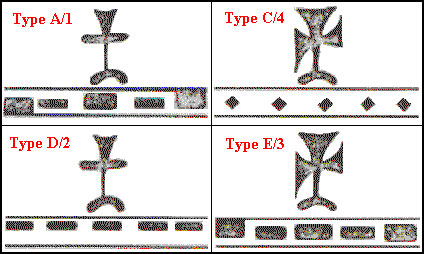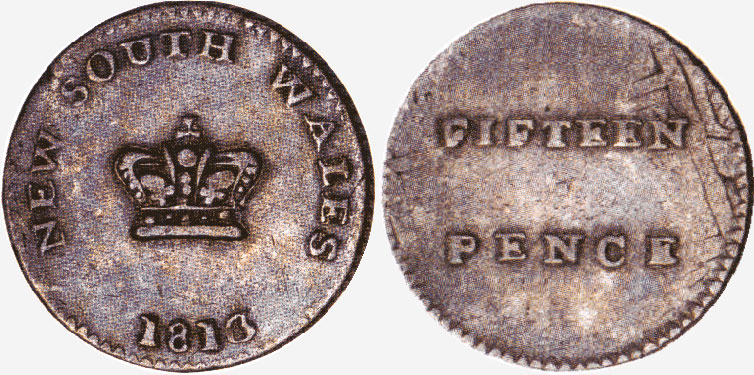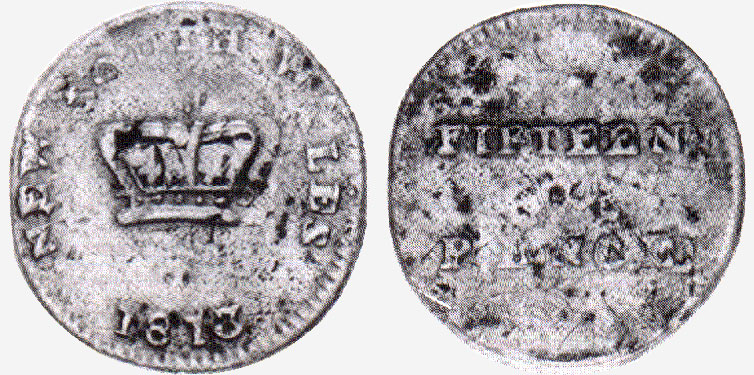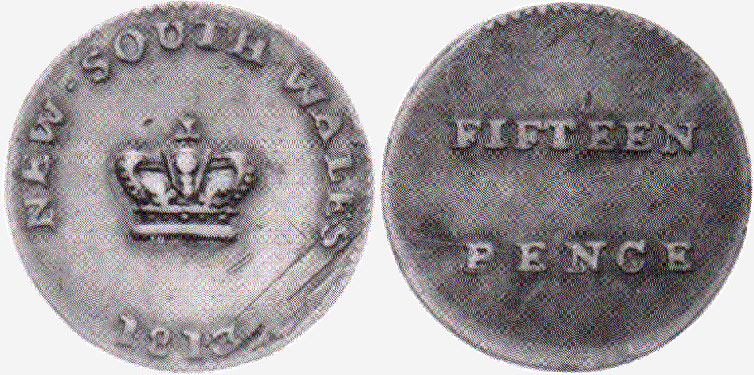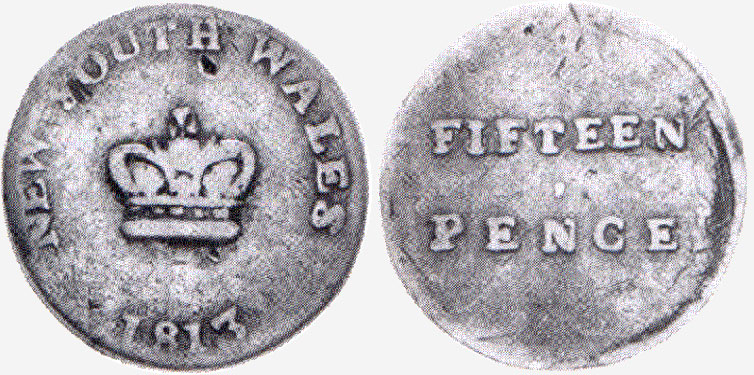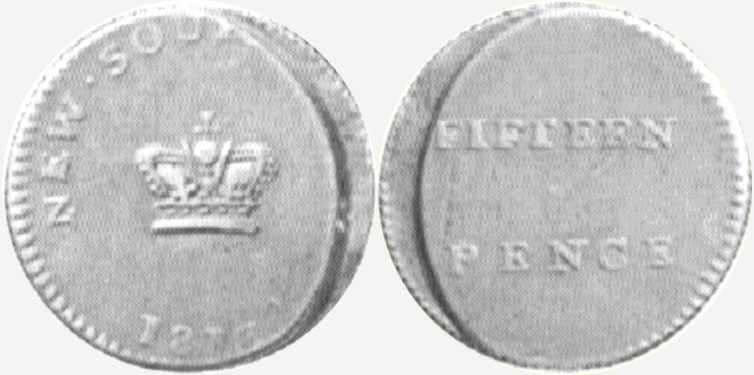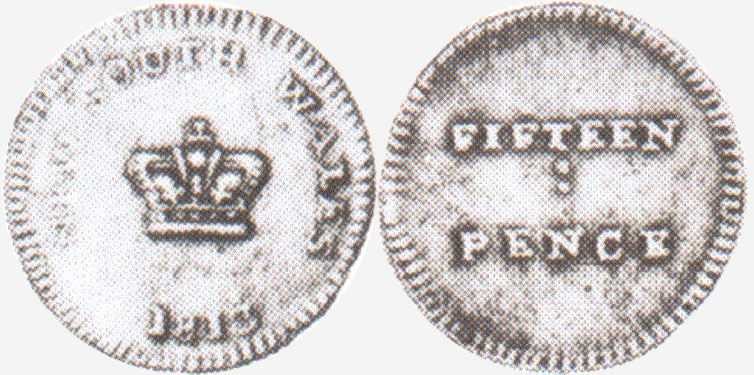N.S.W. Dump (Fifteen Pence) 1813
By AG | Monday, 15 September 2003
Of the 40,000 original Spanish dollars, the records indicate that around 39,910 survived the production process. 190 years later, approximately 1,500 dumps have survived. Of those, less than 1,000 are able to be identified, the balance being worn beyond recognition. Little did Lachlan Macquarie, Governor of the colony of NSW, realise the legacy that these small coins would provide for future historians and numismatists.
Documentation on the method of manufacture used in the production of the dump has never been found. The method proposed is conjecture, based on technology and tools available in the colony at the time. It is safe to assume that whatever machinery was employed, it was hand operated as the first steam engine did not become operational in the colony until 1815. Likely production candidates are the screw press, drop hammer or hand held punch with the drop hammer method onto a pre-heated plug generally regarded as the most likely.
The haphazard, obliquely grooved, edge milling found on dumps indicates that a 'fiddle method' was the final step in the production process. In this process, a roll of stamped dumps was placed between a plain and an obliquely grooved cylinder and rotated under pressure. Each dump would have been a slightly different size from the punching and stamping process with edges which were not necessarily square. This accounts for the varying depth of the grooves on different pieces and for its absence on portions of the rim of the same piece.
Based on a detailed analysis of approximately 300 known examples, four distinct types (die combinations) have been identified for the Dump. On the obverse, variations occur in the shape of the cross on the crown, the position of this cross in relation to the letters in the legend above and in the positioning of the row of jewels (or pearls) in the crown. On the reverse, differences are found in the distance between the words FIFTEEN and PENCE and in the position of the T in FIFTEEN in relation to the N in PENCE. Examples which differ from the four identified types have not been found. From this, it is reasonable to assume that if one side of a dump can be identified/classified, then the entire piece can be given a type code.
The lack of mulings between the four separate obverse and reverse dies remains a mystery. Perhaps the design of the drop hammer was such that when one die broke, the force of the impact also shattered the second die.
The four types have been classified (Mira/Noble) as A/1, D/2, C/4 and E/3. Of the known surviving pieces, 70% have been identified as type A/1, 25% as type D/2 and 4% as type C/4. Only fifteen examples (1%) of the E/3 type are known to exist. The crude type C/4 appears to have been an early die combination, probably used for trials while the correct striking pressure and planchet temperature were worked out. Most have surface cracks and splits attesting to this. The almost as crude type E/3 also appears to have been been used for trials. Types A/1 and D/2, with their symmetrical crosses, neater letters and more artistic overall design were selected and used for the majority of the dumps produced.
The relatively high percentage of surviving pieces has led some historians to the belief that the trial dies may have been used to complete the production run when the last of the major dies shattered near the end of the project. Another theory to explain the seemingly high percentages is that William Henshall forged dumps using the trial dies.
N.S.W. Dump (Fifteen Pence) - 1813 (A/1 type - Andrews 709, 712, 715)
On A/1 types, a symmetrical cross at the top of the crown is positioned between the T and H in SOUTH above. The first pearl in the band on the crown touches the base while the last touches the top. On the reverse, the words FIFTEEN and PENCE are 4.5mm apart with the upstroke of the T in FIFTEEN above the centre of the N in PENCE. All of the major design features show evidence of recutting or duplication.
N.S.W. Dump (Fifteen Pence) - 1813 (C/4 type - Andrews 713)
On A/1 types, a symmetrical cross at the top of the crown is positioned between the T and H in SOUTH above. The first pearl in the band on the crown touches the base while the last touches the top. On the reverse, the words FIFTEEN and PENCE are 4.5mm apart with the upstroke of the T in FIFTEEN above the centre of the N in PENCE. All of the major design features show evidence of recutting or duplication.
N.S.W. Dump (Fifteen Pence) - 1813 (D/2 type - Andrews 710, 711)
On D/2 types, a symmetrical cross (similar to type A/1) at the top of the crown is positioned between the U and T in SOUTH above. The pearls in the band are elongated rectangles and lie evenly spaced but closer to the upper line of the band (often touching the line in worn examples). On the reverse, the words FIFTEEN and PENCE are 5.0mm apart with the upstroke of the T in FIFTEEN well to the left of the N in PENCE. There is no evidence of recutting.
N.S.W. Dump (Fifteen Pence) - 1813 (E/3 type - Andrews 714)
On E/3 types, an asymmetrical cross (similar to type C/4) at the top of the crown is positioned between the T and H in SOUTH above. The first pearl in the band on the crown touches the top while the last touches the base. On the reverse, the words FIFTEEN and PENCE are 3.5mm apart with the upstroke of the T in FIFTEEN over the left upstroke of the N in PENCE. Again, there is no evidence of recutting.
Mis-struck Dump
Reproduction
A single dump design casting was used, based on the type A/1 die combination. All reproductions show a fault of two stops between the words FIFTEEN and PENCE on the reverse. The lower, square dot corresponds to genuine dumps while the upper dot is round and missing on a true specimen.
The reproduction dumps are thinner (1.0 mm) than genuine dumps (average of 1.5mm) and have no edge milling. The reproduced denticle pattern around the rim is exaggerated when compared to that found on real pieces.

